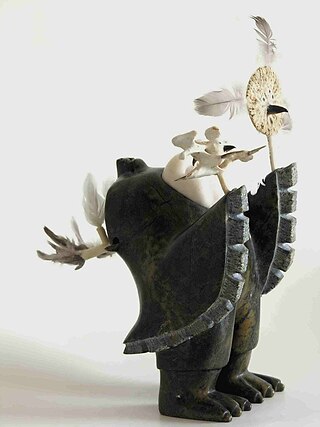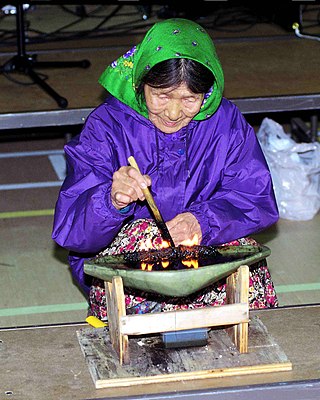The Sun and the Moon is an unipkaaqtuat, a story in Inuit folklore. The traditional explanation for the movement of the Sun and Moon through the sky is that a brother and sister are constantly chasing each other across the sky. The story also explains the moon's dappled gray appearance as soot smeared on his face.

Pitseolak Ashoona was an Inuk Canadian artist admired for her prolific body of work. She was also a member of the Royal Canadian Academy of Arts.
The Thule or proto-Inuit were the ancestors of all modern Inuit. They developed in coastal Alaska by the year 1000 and expanded eastward across northern Canada, reaching Greenland by the 13th century. In the process, they replaced people of the earlier Dorset culture that had previously inhabited the region. The appellation "Thule" originates from the location of Thule in northwest Greenland, facing Canada, where the archaeological remains of the people were first found at Comer's Midden.

The Dorset was a Paleo-Eskimo culture, lasting from 500 BCE to between 1000 CE and 1500 CE, that followed the Pre-Dorset and preceded the Thule people (proto-Inuit) in the North American Arctic. The culture and people are named after Cape Dorset in Nunavut, Canada, where the first evidence of its existence was found. The culture has been defined as having four phases due to the distinct differences in the technologies relating to hunting and tool making. Artifacts include distinctive triangular end-blades, oil lamps made of soapstone, and burins.

Peter Pitseolak (1902–1973) was an Inuk photographer, sculptor, artist and historian. Pitseolak was Baffin Island's first indigenous photographer.

Annie Pootoogook was a Canadian Inuk artist known for her pen and coloured pencil drawings. In her art, Pootoogook often portrayed the experiences of those in her community of Kinngait, in northern Canada, and memories and events from her own life.

Inuit art, also known as Eskimo art, refers to artwork produced by Inuit, that is, the people of the Arctic previously known as Eskimos, a term that is now often considered offensive. Historically, their preferred medium was walrus ivory, but since the establishment of southern markets for Inuit art in 1945, prints and figurative works carved in relatively soft stone such as soapstone, serpentinite, or argillite have also become popular.

Osuitok Ipeelee was an Inuk sculptor who lived in Cape Dorset, Nunavut. His sculptures in green soapstone of caribou and birds are particularly valued for their balance and delicacy. He was an early collaborator with James Archibald Houston, and by Houston's account was instrumental in the conception of the West Baffin Island Eskimo Cooperative. He was also one of the witnesses of the last-remembered traditional Inuit trial.

Pauta Saila was an Inuit artist from Kilaparutua, Baffin Island, Canada who resided in Cape Dorset, Nunavut. His sister was artist Sharni Pootoogook.

Historically, Inuit cuisine, which is taken here to include Greenlandic, Yupʼik and Aleut cuisine, consisted of a diet of animal source foods that were fished, hunted, and gathered locally.

The Inuit are an indigenous people of the Arctic and subarctic regions of North America. The ancestors of the present-day Inuit are culturally related to Iñupiat, and Yupik, and the Aleut who live in the Aleutian Islands of Siberia and Alaska. The term culture of the Inuit, therefore, refers primarily to these areas; however, parallels to other Eskimo groups can also be drawn.

Kananginak Pootoogook was an Inuk sculptor and printmaker who lived in Cape Dorset, Nunavut, in Canada. He died as a result of complications related to surgery for lung cancer.

Napachie Pootoogook was a Canadian Inuit graphic artist.
Alashua Aningmiuq (1914–1972) was an Inuk graphic artist and a carver in Nunavut, Canada working in the 1950s and 1960s.

Kiugak Ashoona was a Canadian Inuk artist renowned for his sculptural work and his expansive artistic portfolio. He experienced the longest career of any Cape Dorset artist, and is a member of the Order of Canada and the Royal Canadian Academy of Arts. In 1999, he was awarded the Canada Council Molson Prize for his outstanding lifetime contribution to the cultural and intellectual life of Canada.
The West Baffin Eskimo Cooperative, also known as the Kinngait Co-operative is an Inuit co-operative in Kinngait, Nunavut best known for its activities in buying, producing and selling Inuit artworks. The co-operative is part of Arctic Co-operatives Limited, a group of locally owned businesses that provide fundamental services in the Canadian north. The co-operative sets prices for the sale of its member's works, pays the artists in advance and shares its profits with its members.

Kiakshuk was a Canadian Inuit artist who worked both in sculpture and printmaking. Kiakshuk began printmaking in his seventies and, is most commonly praised for creating “real Eskimo pictures” that relate traditional Inuit life and mythology.
Iyola Kingwatsiak was an Inuit visual artist from Kinngait.
Sharni Pootoogook (1922–2003) was an Inuit printmaker from Cape Dorset, Nunavut.

Eegyvudluk Pootoogook (1931-2000) was an Inuk printmaker and sculptor. He was married to the artist Napachie Pootoogook.

















